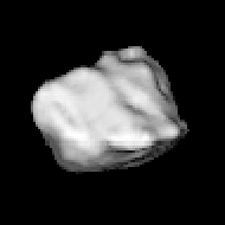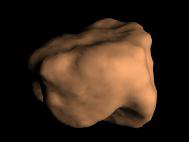
This computer model, based on radar observations, accurately shows the nooks and crannies within minor planet 6489 Golevka.
Courtesy NASA/JPL.
Astronomers tracking asteroids in their orbits by radar have directly observed the Yarkovsky effect — a long-proposed force imparted on asteroids by sunlight. The force is subtle — in the case of minor planet 6489 Golevka, it's the equivalent of one ounce of thrust pushing against a 0.5 kilometer, 210 million-ton tumbling "mountain."
A team led by Steven R. Chesley and Steven J. Ostro (NASA/Jet Propulsion Laboratory) focused on the spinning asteroid and measured the minute orbital change it incurred between 1991 and 2003. In that time they found that the object's path had shifted 15 kilometers from what would be expected based on gravitational interactions with other solar-system bodies.
The Yarkovsky effect arises when sunlight warms a rotating asteroid. Absorbed thermal energy is radiated away when the heated face of the rock rotates to one side. The departing infrared photons create a feeble "rocket effect" that imparts a sideways force. Over time, the exiting photons gradually change the asteroid's orbit. Rocks that rotate in the same direction as they revolve will slowly achieve wider orbits. The converse is true — opposite spinners slowly spiral into the Sun.

Spinning asteroids radiate more heat during their 'afternoons' than 'mornings.' So an object rotating in the same direction it is revolving (A) will emit thermal radiation in a direction that slightly increases its orbital speed, moving it out toward from the Sun. Opposite spinners (B) will lose orbital energy and move closer to the Sun. This subtle effect, first proposed around 1900 by Polish engineer Ivan O. Yarkovsky, has been detected directly for the first time.
S&T Illustration: Steven Simpson
In addition to spin, Yarkovsky involves more than a dozen other factors. One important variable is the material property of the object. The amount of sunlight absorbed and the time lag for re-radiation depend respectively on the reflectivity and heat capacity of the asteroid's surface.
Extremely precise radar observations spanning many years were critical for measuring the minuscule orbital deflection. "We need three widely spaced [in time], high-quality radar apparitions," says Chesley.
In a 2000 Icarus paper, Chesley and others predicted that the May 2003 apparition of well-studied Golevka would reveal that the asteroid had shifted its orbit due to sunlight. Three springtime observations with the Arecibo Observatory in Puerto Rico later, the 2000 prognostication proved positive. "It's always exciting when you can make an prediction and observations bear it out," says Chesley.

This 6-megabyte Quicktime animation shows 6489 Golevka rotating in 3D.
Courtesy NASA/JPL.
Several factors needed to be addressed for the researchers to be sure that what they were seeing was really Yarkovsky in action. The largest potential for error was a perturbation from an unknown passing asteroid. But after careful analysis, the team became convinced that interloping asteroids weren't the culprits. "There is no room for confusion as to what the measured effect was."
Nailing down Yarkovsky allowed the team to make another measurement — the first-ever mass determination of a lone asteroid. (Rocks with satellites, such as 243 Ida with its moonlet Dactyl, are "weighed" by timing the orbit of one around the other.)
Astronomers are watching about two dozen other objects whose orbits are refined enough to look for the effect. Determining how and if those rocky princesses feel the Yarkovsky peas will speak volumes about their differing thermal conductivities and other characteristics, as well as providing masses for previously immeasurable bodies.
The results appeared in the December 5, 2003, issue of Science.
 0
0
Comments
You must be logged in to post a comment.